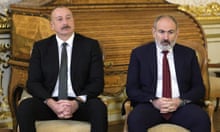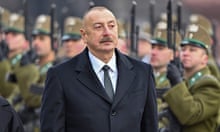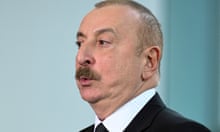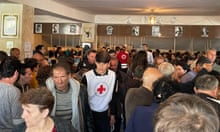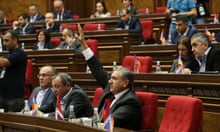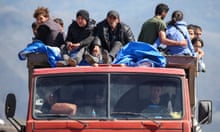Russian peacekeepers have deployed to Nagorno-Karabakh after Moscow brokered a peace deal that sparked celebrations in Azerbaijan and protests in Armenia, where demonstrators briefly occupied government buildings.
The truce, announced late on Monday night, calls for the deployment of nearly 2,000 Russian peacekeepers to the disputed enclave, where Azerbaijan will receive significant territorial concessions from an Armenian-backed local government.
The ceasefire may end a six-week war in which Azerbaijan launched its largest offensive in a generation to retake Nagorno-Karabakh and surrounding regions under Armenian control. Since fighting began in late September, thousands have been killed and more than 100,000 displaced in the worst fighting since the early 1990s.
The agreement confirmed the influence of Russia and Turkey in the region, while sidelining western powers. Russia on Tuesday denied that Turkish peacekeepers would be allowed to deploy to Nagorno-Karabakh despite claims that they would by Azerbaijan’s president, Ilham Aliyev.
“The deal ends six weeks of heavy fighting, but is not a comprehensive peace treaty,” said Olga Oliker of the International Crisis Group in a statement, adding that many details of the ceasefire “remain vague”.
Michael Carpenter, an adviser to the US president-elect, Joe Biden, described the deal as a geopolitical victory for Vladimir Putin.
News of the deal set off a protests in the Armenian capital. Hundreds of people took to the streets and stormed government buildings soon after Armenia’s prime minister, Nikol Pashinyan, announced the “painful” deal early on Tuesday.
Windows were smashed and broken glass littered the lobby of Pashinyan’s official residence. Protesters ripped his nameplate off his office door as others chanted: “Nikol has betrayed us.”
Police officers looked on as demonstrators – including some army veterans wearing military fatigues – filled the ornate, wood-panelled offices, shouting and delivering furious speeches.
Q&AWhy are Armenia and Azerbaijan fighting over the Nagorno-Karabakh region?
Show
Early on Sunday 27 September, Armenia announced it was declaring martial law, mobilising its army and ordering civilians to shelter. It claimed its neighbour Azerbaijan had launched a military operation inside a breakaway region called Nagorno-Karabakh. Azerbaijan said it attacked only in response to Armenian shelling.
Nagorno-Karabakh is recognised internationally as Azerbaijan’s territory but has a mostly Armenian population who have resisted Azerbaijani rule for more than a century. In 1991 the region of around 150,000 people declared independence and since then it has ruled itself – with Armenian support – as the unrecognised Republic of Artsakh.
Nagorno-Karabakh, a mountainous, landlocked region inside the borders of Azerbaijan, has been a source of dispute since before the creation of the Soviet Union. Tensions were suppressed when both Armenia and Azerbaijan were Soviet states, but they re-emerged as the cold war ended and Communist party control of the bloc dissolved.
A war between Armenian and Azerbaijani forces ended in a ceasefire in 1994, with Armenia in full control of Nagorno-Karabakh and other surrounding enclaves of Azerbaijan’s territory. Azerbaijan is majority Muslim and Armenia is majority Christian, and some elements on both sides seek to cast the conflict in religious terms.
Crowds also forced their way into the Armenian parliament as brawls broke out on the podium and objects were thrown. The parliament’s speaker, Ararat Mirzoyan, was caught up in the violence and beaten unconscious by an angry mob.
Pashinyan and senior figures in the Nagorno-Karabakh administration said they were forced to sue for peace. Azerbaijani forces had captured the enclave’s strategically positioned town of Shusha and appeared to be within striking distance of the region’s largest city, Stepanakert.
Fighting over Nagorno-Karabakh broke out on 27 September. The region has been under the control of ethnic Armenian forces backed by Armenia since 1994.
Azerbaijan said it had retaken much of the land in and around Nagorno-Karabakh that it lost in a 1991-94 war over the territory that killed an estimated 30,000 people and forced many more from their homes. Armenia has denied the extent of Azerbaijan’s territorial gains.
Arayik Harutyunyan, the leader of the Nagorno-Karabakh government, said on Tuesday that he had agreed to the peace terms in consultation with Pashinyan.
“If the fighting had continued, we would have lost the whole of Artsakh within a few days, and we would have had more victims,” he said, referring to Nagorno-Karabakh, in a video posted online.
Armenian opposition parties have called for the government to revoke the agreement. And the country’s president, Armen Sarkissian, distanced himself from the deal, saying he had learned about the negotiations from the media and calling for “political consultations” to find a path out of the crisis.
The agreement calls for Armenian forces to turn over control of some areas it held outside the borders of Nagorno-Karabakh, including the eastern district of Agdam. That area carries strong symbolic weight for Azerbaijan because its main city, also called Agdam, was thoroughly pillaged, and the only building remaining intact is the city’s mosque.
Armenians will also turn over the Lachin region, which holds the main road leading from Nagorno-Karabakh to Armenia. The agreement calls for the road, the so-called Lachin corridor, to remain open and be protected by 1,960 Russian peacekeepers. Stepanakert will remain under control of the Armenian-backed government.
The deal announced overnight on Tuesday was “absolutely momentous” in the more than a century-long modern history of the dispute, said Laurence Broers, the Caucasus programme director at Conciliation Resources, a peace-building group.
Apart from regaining territory it lost in a 1990s war with Armenia, Azerbaijan also appeared to have taken off the table questions of a referendum to decide the future of Nagorno-Karabakh that had been a feature of peace talks over the past two decades.
News footage on Tuesday showed peacekeepers from Russia’s 15th Motorised Rifle Brigade boarding military planes from Russia and later departing the Armenian city of Goris in military transports headed toward Nagorno-Karabakh.
The deal stipulated they would be deployed to the Lachin corridor for five years, establishing Russia’s role as peacemaker in the region for the foreseeable future.
“I personally made a very hard decision for myself and all of us,” Pashinyan said in a statement posted online, describing the ceasefire terms as “unbelievably painful for me and our people”. In a video address, Aliyev taunted Pashinyan, saying he had signed the agreement because of his “iron fist.”

The agreement also calls for transport links to be established through Armenia linking Azerbaijan and its western exclave of Nakhchivan, which is surrounded by Armenia, Iran and Turkey.
The deal leaves a cloud of uncertainty over parts of Nagorno-Karabakh that will continue to be administered by local ethnic Armenian authorities including the enclave’s main city Stepanakert, whose main road to Armenia will be in Azerbaijani control and overseen by Russian peacekeepers.
“It could end up being a strange, highly securitised area,” said Broers. “Maybe the calculation is that it’s going to be such an awful place to live that most of the Armenian population – most of whom have already left – won’t come back.”
Azerbaijan’s president confirmed the news in a televised online meeting with Vladimir Putin, president of Russia, which has a defence pact with Armenia and a military base there. Turkey has been supporting its ally Azerbaijan.
“The signed trilateral statement will become a [crucial] point in the settlement of the conflict,” Aliyev said.
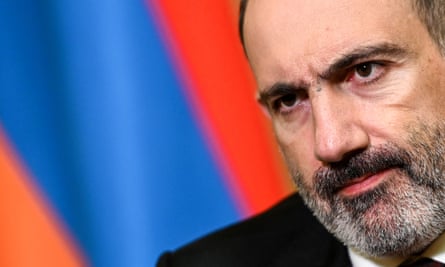
Aliyev also claimed that Turkish peacekeepers would be deployed as part of the agreement, although no details have been made public.
Putin said in a statement on Tuesday that he hoped the deal “will set up necessary conditions for long-lasting and full-scale settlement of the crisis over Nagorno-Karabakh”.
Pashinyan came to power in 2018 in a bloodless democratic revolution and there are already fears the loss of territory may provide an opportunity for authoritarian forces to reclaim power.
Reuters and Associated Press contributed to this report.
